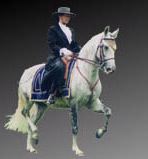 |
classicaldressagescotland.com |
| Lesson 18: Extended Paces part 1 - Lengthened, Medium and Extended |
| New web address: www.classicaldressagescotland.com |  |
| About this site | About us | Personal Tuition | Video analysis | Lesson menu | Portugal and Lusitanos |
| Home Schooling Classical dressage Modern dressage Horse trials Show jumping Glossary Links |
In the early nineties I was wandering around the Goodwood International Dressage competition and I was introduced to a very prominent, successful Swiss rider. We got chatting over the odd glass of wine; she wasn’t riding again that day, although if she had had been her half passes would have been spectacular if her ability to stagger sideways was any thing to go by, anyway I digress. Amongst other things we got to discuss and chat about the extended paces and the importance of the horse going forward. She told me that most Grand Prix riders when they ask their horses to extended trot or canter, the good ones, the spectacular winning ones, really don’t know if they will be able to stop their horse or present a half decent transition at the target letter. The point being, the horse must be totally committed to going forward and enjoying the sensation, giving the appearance of ‘not wanting to stop’. If you remember this little anecdote when teaching your horse or trying to improving your lengthened paces you won’t go far wrong. When you at last get true cadenced extended trot and you can sit to it, there is no other buzz like it! Except flying changes of course, but that’s a difference story. Now for the Rules, Regs and the 'This is what you do bit'. What are Extended Paces.It’s what it says on the tin. The horse should go from point A to point B in the fewest number of strides possible. This means that the horse should open his/her legs further, to cover more ground with each stride and remain in balance and cadence. This is what the British Horse Society has to say which is as good as any- And I quote:-
The LessonBefore you ask your young horse to lengthen stride you have to ask yourself, as the trainer a few questions;
And if you are asking your older horse to lengthen and he has never offered before there are a few more questions to ask: If the answer is something like, ‘he has never been asked or taught’ then there is not going to be a problem, just refer to the above. However if it is that the horse has suffered some sort of trauma while being asked to lengthen or the horses temperament is a little too fizzy or even the horses breeding, e.g. Shetland ponies are great but they don’t present extravagant lengthened strides in the classical sense or there might be a conformation problem, then, you might just have to accept what the horse can give and be grateful. If you have answered all your questions and the answer is yes done that, got the tee shirt and all is sorted, then you can get on with the job and get your horse moving at two hundred miles an hour and putting every goose that ever stepped to shame. The WalkThere are four paces in the walk recognised by most dressage competitions I have already explained the basic walk pace in an earlier lesson so I will just concentrate on the lengthening. Free Walk. This walk is a pace for relaxation. You allow the horse to stretch and lower the head and neck with complete freedom. Your horse should cope with this pace just on its own without any influence from you, the rider.
Collected Walk. The subject for a future lesson. Medium Walk The FEI says this is a free, regular and unconstrained walk of moderate lengthening. The horse remaining on the bit. Walks energetically, but calmly, with even and determined steps (and this is the important bit) the hind feet touching the ground in front of the footprints of the fore feet.
This is where you might have to do some experimenting. There are some schools of thought that says the rider should use alternate legs to create impulsion, others will tell you that you will have to use both legs at once to encourage the hind legs to step more underneath the horse thereby increasing the length of stride. This is a suck it and see situation. Try both and what works for you and your horse, stick with it. The only thing that I must emphasise is that your hands must move in sympathy with your horse’s head and neck. To follow the movement. Your horse must not feel any restraint. Your back must be soft and supple moving with the walk and sitting straight. He must move with freedom and not feel stitched-up.
Of course while all this following and giving with hands is going on, your horse must remain on the bit. Try not to thump your horse’s sides with your legs. Whatever leg aids you adopt, repeated kicking and thumping looks horrible and if you keep doing it I will disown you but more importantly, it will upset your horse and teach him to ignore your aids.
Extended Walk I quote again from the FEI rule book. The horse covers as much ground as possible, without haste and without losing regularity of the steps (same as medium but again this is the important bit) the hind feet touching the ground clearly in front of the footprints of the fore-feet. Subtle difference!
If you have been thumping your horses sides with your legs then extended will be extremely difficult. Why? Because you will have to use a little more weight in your legs to get the extended walk. If you have been using too much leg to get medium, Dobbin will just ignore you. Once again, don’t stitch your horse up, be supple, following with sympathetic hands and allow your horse to stretch out, over his back, but still remain on the bit. I have found over the years that to improve the walk is always difficult. I think that’s why the old stud grooms and horsemen/women who know what they’re doing, especially when buying a horse, will always say that if the walk was good, all the other paces will be fine. Just one more tip before going on to the trot. If you are having trouble with the walk, choppy short strides, lazy etc, find another horse in your local area that has a good walk, a big walk and go hacking/trail riding with him. The horse with the bigger stride will encourage your horse to keep up without any effort from you except to keep the walk and not to trot. The TrotCollected Trot. The subject for a future lesson. Working Trot. This is the basic trot pace for most of your work. Hence ‘working’. Refer to an earlier lesson regarding the paces; however it’s worth while giving you what it says in the FEI manual. It will help you define and fine tune your work. And I quote: This is a pace between the collected and the medium trot, in which a horse, not yet trained and ready for collected movements, shows himself properly balanced and remaining ‘on the bit’ goes forward with even, elastic steps and good hock action.The expression ‘good hock action’ does not mean that collection is a required quality of working trot; it only underlines the importance of impulsion originating from the activity of the hind quarters. Lengthened Strides. There is a lot of confusion about this pace. This pace, especially in trot is to introduce a young horse to the extended paces and to demonstrate to a judge that the training is progressing and the work has, up to that level, been correct. Lengthened stride just means that your horse should start to show that he is able to keep his balance and cadence and is able to move from point A to point B faster but without running. The problem is that if you have two horses in the same competition, the horse that is already doing a decent medium trot will always get more marks than the horse that, albeit correctly, just shows a few lengthened strides. The real problem is that there is no age limit for horses in the lower levels of dressage competition. What can you do about this? Well not a lot. The only advice I can give you is that if you compete at the lower levels, prelim and novice, you will have to live with this problem or teach your horse to medium trot before you present your horse to a judge. What you must not do is push your young horse too quickly and ask for medium or extended trot before he is ready. Medium Trot. Once again I’m going to quote from the good book. I think it’s important to get all these paces into context. I know it’s a bit of a yawn but in the words of the poet and prophet, tough! Quote: This is a pace between the working and the extended trot but more ‘round’ than the latter. The horse goes forward with clear and moderately lengthened steps and with obvious impulsion from the hind quarters, always keeping the same character as in the working trot. (And this is the important bit. You will see why later) The rider allows the horse, remaining ‘on the bit’ to carry his head a little more in front of the vertical than at the collected and the working trot, and allows him at the same time to lower his head and neck slightly. How do you teach your horse to lengthen and medium trot? This is what you do. For the first year or perhaps year and a half after backing your young horse, the only lesson you should be teaching your horse in working trot is to go forward from your leg and maintain rhythm, tempo and balance. To be round ‘on the bit’ and to go for him or herself without you having to kick all the time. To be light in the hand. To be able to turn or circle without having to pull at the reins and to carry the riders weight without any problems. If you have all that then your horse is ready to lengthen. Go rising trot. Ask your horse to go from point A to point B faster but still stay in the same tempo. There’s only one thing your horse can do if it stays in the same trot rhythm and that is open/lengthen their legs further to get there faster. And that is basically it. I know that sounds too simplistic, too easy, but if all your preparation has been done properly, all those training problems that we all have with our horses have been ironed out, then there should be no problems. Oh, and if your young horse does decide to give you the most amazing lengthening or even medium trot, try no to be too shocked and get left behind. There’s nothing more likely to stop a horse going forward than to be socked in the mouth. If you are lucky enough to have a horse with the natural ability to extend then you have probably already felt the difference between working and lengthening and this should be an easy lesson, but you might want to read part II to improve it. The most common problem when you first ask your horse to extend is that if your canter aids have been sloppy or there has just been confusion with speed and a transition, your horse might canter. Don’t punish the horse, just bring him back to working trot and ask again. The import message you give your horse is; that if you feel just the slightest lengthening bring your horse back to working trot, reward, sometimes walk and reward. Pat on the neck, kind soft words. This is the incentive for him/her to do it again.
Just a few words from Nuno Oliveira; Never ask for more than he is capable of giving. Make him a companion, and not a slave, then you will see what a true friend he is. If you have any problems or questions, just email but please wait until part ll is written if your questions are about the extended paces. Good luck and enjoy.
|
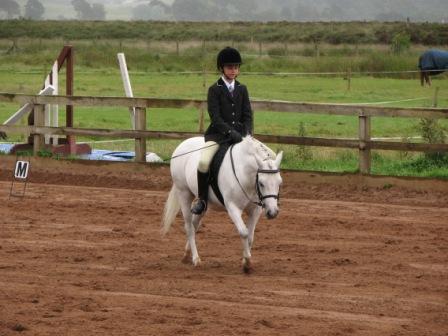
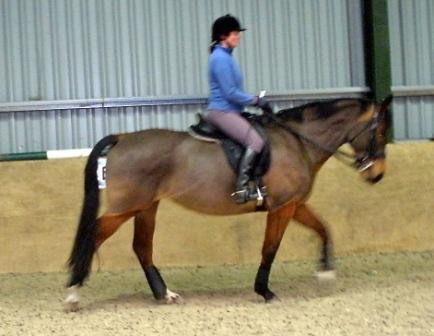
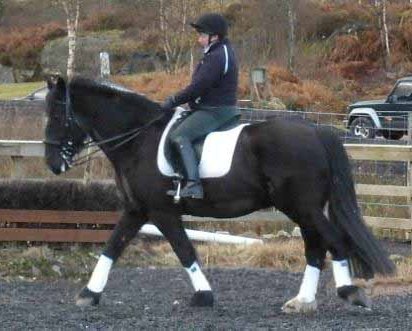
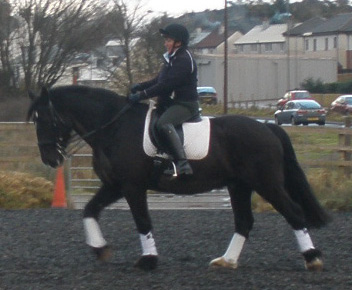
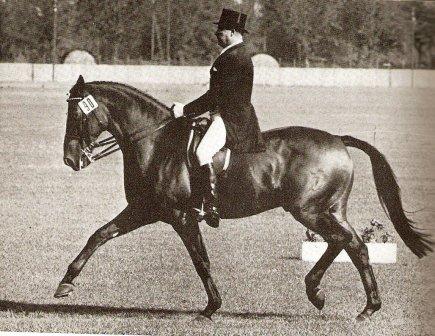 The steps should be even, and the whole movement balanced and unconstrained.
The steps should be even, and the whole movement balanced and unconstrained.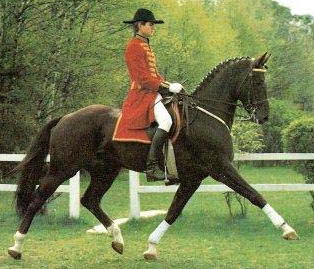 In the next lesson Extended Paces part ll I will talk about the extended trot, lengthening in canter, how to teach the older horse to lengthen and exercises to make the extended paces better and sort out any problems.
In the next lesson Extended Paces part ll I will talk about the extended trot, lengthening in canter, how to teach the older horse to lengthen and exercises to make the extended paces better and sort out any problems.